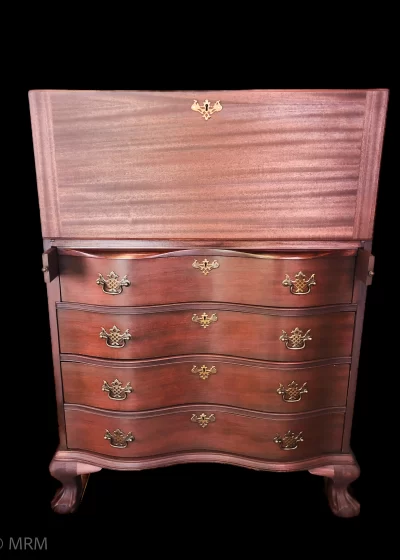Slant Top
From Dropleaf to Deco: A Slant-Top Symphony Through the Ages
The slant-top desk, more than just a piece of furniture, is a melody of function and form, weaving its way through centuries of design history. From humble beginnings to lavish displays of craftsmanship, its angled lid and intricate features whisper tales of writing, innovation, and the evolving needs of a scribbling world.
First Notes: Medieval Roots and Dropleaf Designs:
The earliest whispers of the slant-top desk can be traced back to medieval writing boxes, portable companions for scribes and scholars. By the Renaissance, these boxes blossomed into elaborate “escritoires,” often featuring hinged tops that angled for easier writing. These early versions, influenced by Italian and Spanish cabinetry, laid the groundwork for the more recognizable slant-top design to emerge.
The 17th Century: Baroque Flourishes and William & Mary’s Grace:
The 17th century saw the slant-top desk flourish, especially in Europe. Baroque influences adorned these pieces with bold curves, inlaid marquetry, and intricate metalwork. In England, the William & Mary style brought a touch of elegance, with graceful cabriole legs and delicate marquetry patterns. These desks became more than mere writing surfaces; they were symbols of status and refinement, gracing the studies of nobility and scholars alike.
Across the Pond: American Ingenuity and The Governor’s Wink:
Across the Atlantic, American craftsmen adopted the slant-top design with their own ingenuity. Drop-front desks, simpler cousins of the European models, offered practicality without sacrificing aesthetics. And then came the “Governor Winthrop” desk, a late 19th-century revival inspired by John Winthrop, though the actual connection is more mythical than historical. These desks, often crafted in rich mahogany with spacious interiors, became synonymous with colonial charm and American craftsmanship.
Beyond Tradition: The 20th Century and the Rise of Modernity:
The 20th century ushered in a new era for the slant-top desk. Art Deco embraced sleek lines and geometric shapes, transforming the traditional form into a symbol of modern efficiency. Mid-century modern designers experimented with materials like plywood and laminate, creating clean lines and playful pops of color. Even with the rise of computers and digital alternatives, the slant-top desk endured, its timeless shape adapting to new trends and needs.
A Symphony of Enduring Melody:
Today, the slant-top desk continues to resonate. Antique collectors cherish its historical lineage, repurposing it as display cabinets or charming conversation pieces. Modern iterations blend classic lines with contemporary materials and functionality, proving that the angled lid’s melody remains relevant in a digital age. The slant-top desk is more than just a piece of furniture; it’s a timeless design, a testament to the enduring allure of craftsmanship, and a reminder that the act of writing, in any form, deserves a stage of its own.
Showing the single result


